If you are thinking about the why and how to develop AI software, be prepared for some impressive facts and lessons you will learn from this article.
First of all, more than 70% of organizations now use AI, compared to only 20% in 2017. This wave is fuelled by a surge in investment, which attracted an impressive USD 200 billion in 2023 and is expected to grow at least 120% annually. Moreover, by the end of 2023, organizations across most industries are equally likely to invest more than five percent of their digital budgets in generative and analytical AI.
But how to create an AI solution? Building your own AI capabilities requires significant resources and expertise. From predictive models to AI assistant development, creating AI software often demands specialized knowledge in machine learning, data engineering, and user experience. For those lacking these resources, partnering with an experienced vendor can be a faster and more efficient way to harness the potential of AI across a wide range of areas.
The CHI team has prepared a guide to tell you how to make your own AI software and what steps you as a business should take at the preparation stage.
What is Artificial Intelligence, and How Does It Work?
Artificial intelligence is a technology that allows computers to perform tasks commonly done by humans.
The main reason why machines are considered human-like comes down to the main traits that define intelligence: learning, reasoning, problem-solving, perception, and use of language.
Learning is probably the most known trait of AI. There are different techniques to teach algorithms to perform specific tasks, and it has proven to be relatively easy.
Reasoning is the ability to draw inferences appropriate to the situation. Although engineers have had considerable success in the reasoning realm, this is still one of the biggest challenges of AI development. The thing is, not all inferences AI draws are relevant to the problem it faces.
AI Matchmaking: Choosing the Right AI Expertise for Your Business Goals
Read more
Problem-solving is the bread and butter of AI and is fairly easy for a computer to do by applying means-end analysis. It looks at a current state and a desired goal. Then defines obstacles between these two states and decides how to overcome them one by one.
Perception for humans is done through our senses. For AI, it is done through sensors and optics powered by сomputer vision.
Use of language is one of the most debated traits. That’s because not so long ago AI couldn’t understand the meaning of words. This has changed thanks to natural language processing (NLP), and now AI can recognize human language and provide answers.
Humanity is at the first steps of creating artificial intelligence, and yet, we can already benefit from the AI we have in our daily lives. But how to make an AI solution work?
To build AI tools, you need a lot of data to train it. You also need a way to process it – a series of instructions written in computer code to teach AI what to do with the data. These instructions are called algorithms.
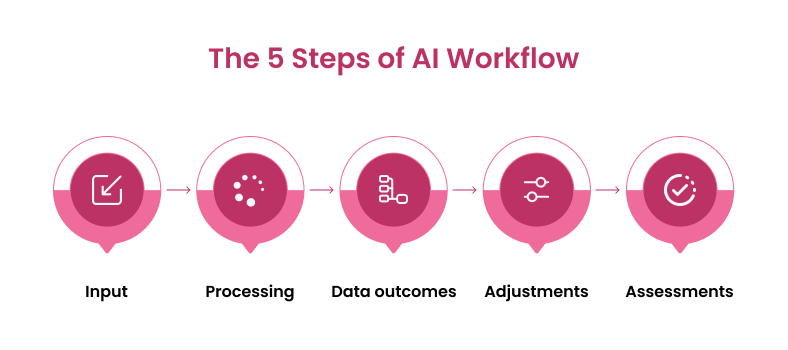
These are the fundamental workflow steps that stand behind any AI solution.
The workflow of AI looks like this:
Input. To perform properly, AI needs a lot of data for training. While data can be any type you want, you should define its context and desired outcomes.
Processing. At this point, AI is looking for patterns and interprets the data you provided.
Data outcomes. After processing, AI predicts the outcomes as failure or success.
Adjustments. If AI predicts failure, it can learn from mistakes and repeat the process.
Assessments. After AI’s work is done, it analyzes the data and makes predictions and inferences.
Different approaches to AI learning involve different technologies, for example:
- Machine learning;
- Neural networks;
- Deep learning;
- Natural language processing;
- Computer vision.
AI technology already changed regular people’s lives for the better, bringing personalized approaches and time optimization. But its potential doesn’t stop there! Let’s look at how AI can help your business.
Through our expertise in computer vision development, Chi Software specializes in creating advanced AI solutions tailored to your business needs. Whether it’s enhancing visual recognition systems, automating quality control processes, or improving data analysis, our computer vision development services can drive innovation and efficiency in your operations.
What Business Problems Can Be Solved With AI?
AI has a vast potential to solve various problems and improve business operations. Every company has its reasons to turn to innovation and develop artificial intelligence software.
According to the IBM research published in January 2024, while adopting or developing AI software, companies address many issues such as needs for cost reduction and automation (42%), competitive and consumer pressure (31% and 25% respectively), labor shortages (25%), or environmental pressures (19%).
About half of the organizations already notice benefits from using AI. These include improvements in IT and network performance (49%), better focus on high-value tasks (45%), faster mean time to resolution (43%), and mitigating labor and skills shortages in IT departments (39%). See more in the IBM report.
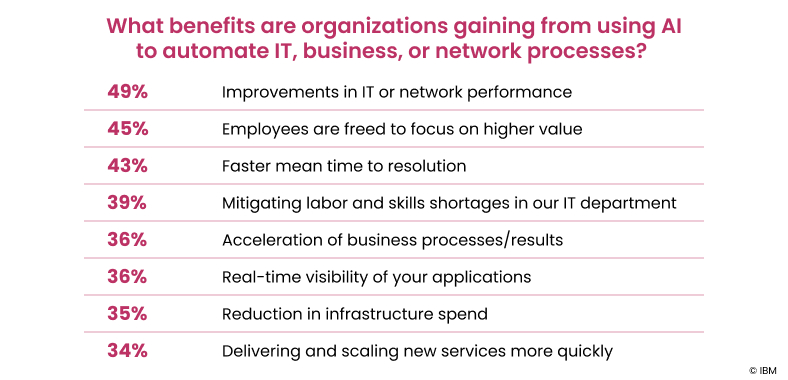
Business benefits of AI adoption according to IBM research
Our experience supports the research statistics. Our clients from different industries and markets efficiently meet various business requests while adopting AI solutions. The most common of them are:
- cost optimization in day-to-day operations,
- better customer experience through personalization,
- higher customer engagement and thus improved customer loyalty,
- sales and revenue increase,
- improved brand differentiation on the market.
Let us look at particular cases of AI adoption and the benefits companies gain when creating artificial intelligence software for their business.
Successful Use Cases of AI Integration: CHI Software Experience
Artificial intelligence in business is a constantly expanding field. Today, there are thousands of examples of AI implementation.
We at CHI Software have been providing AI software development services since 2019, creating sophisticated solutions in various domains.
AI in Retail: Computer Vision Solution for a Cosmetic Retailer
For as long as the cosmetic industry existed, it was dependent on physical stores where customers could try out beauty products before buying them. But times are changing, and with the introduction of AI into the mass market, companies need to adapt their business models. That’s why a cosmetics retailer from the US contacted us with the idea of an AI-driven mobile app.
Our client had a variety of beauty products for different skin types, under-eye care, and decorative cosmetics. To improve customer experience, they were looking to build an AI mobile solution to analyze the customer’s face and skin type and then offer the best-fitting products. Being a ChatGPT development company, we could provide our client with the smartest AI chatbot for the best project outcomes. This advanced solution showcases the immense potential of Generative AI in retail.
The main goals behind this project were to optimize the processes and minimize human labor since training consultants to serve everyone is a fairly expensive and time-consuming process.

This is how one selfie can help a customer make the right choice about cosmetics.
Our team isn’t new to facial recognition development, so we presented our client with mobile software based on computer vision. The process is simple:
- The user takes a selfie;
- The program detects a face on the user’s photo;
- The solution analyzes the user’s unique facial features;
- AI algorithms help select skincare products based on face analysis;
- The solution provides a user with personalized recommendations with the help of ChatGPT API integration.
This app helps customers not only with a better overview of available items but also with picking cosmetics best fitting for a certain skin type and user preferences.
Rome wasn’t built in a day, as well as our product. It took two years of work with a dedicated team of engineers, designers, and managers. The app was rolled out in phases, gradually introducing new functionality and fine-tuning to meet our client’s criteria.
The market received the tool warmly and generated a lot of talk in the industry. Our client, in turn, achieved the desired results:
- Enhanced customer support: 24/7 client support thanks to the AI chatbot that never sleeps;
- Better customer engagement: 10+ million downloads;
- Improved sales conversion: the conversion rate rose by 38% because of personalized suggestions;
- Data-driven insights: AI supports marketing and product development by providing real-time customer data analysis.
Like any great solution, this one required tremendous work and resources. And judging by the results, the client’s investment paid off. If you’re eager to learn more, continue exploring this case study on our website.
AI in Logistics: Robotic Process Automation Solution
The Covid pandemic was a tough time for a lot of industries for obvious reasons. Some of them were hit more than others from a profit perspective, for example, tourism and logistics.
It was challenging for our Canadian client as well. As a logistics company, they had to deal with a lot of documents, such as invoices, bills of lading (BOL), proofs of delivery (POD), carrier supplier confirmations, and so on.
All of this work was done by humans, and since a lot of companies started to lose money during Covid, having a large staff made it harder to stay afloat.
Every set of documents was up to 25 files in different formats and languages, processed by a vast human staff. To save company value and optimize profits, our client started looking into robotic process automation (RPA) solutions that could handle high-volume, repetitive, and time-consuming tasks.
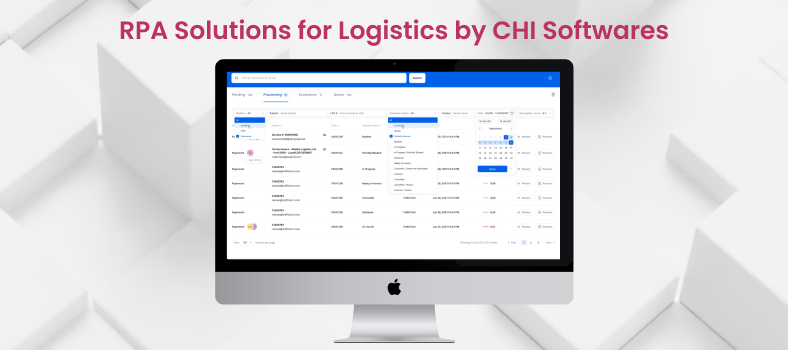
Such a solution can handle a big portion of repetitive manual tasks to free up our client’s resources.
We delivered an RPA solution based on machine learning, natural language processing, computer vision, and character recognition. The platform entirely removed manual human labor out of the general workflow thanks to the following features:
- The system receives incoming logistics documents;
- It uploads one-page documents as scanned images;
- Then, algorithms determine the type of document by checking for text and signatures (if they are provided), detects QR codes;
- The platform compares new data with the data entered earlier in the system
- Finally, the software returns with a request/response through the API.
But our solution continues. RPA allows for expanding and editing existing data in documents. Since this project is still ongoing, our next step will be creating a service for automatic reading and processing emails and developing a web tool to sort the results of this work.
Would you like to learn more details? Continue reading this case study via the link.
AI in Construction: Building Automation System
Construction of a building is a slow and tedious process. It requires a lot of precision and calculations to ensure the stability of a structure and the ability to withstand harsh weather.
Seismic activity is one of the most devastating hazards for buildings. This requires them to ensure the stability of structures during the construction process.
To demonstrate that the required number of reinforcing bars is available, builders must attach colored markers to each section of the reinforcing mesh. Those markers can fall off, and the process has to be repeated hundreds of times.
Our client from Japan came to us with this exact problem in 2021. Our task was to develop an AI solution that automates the control over reinforcing rod placement on construction sites.
It was hard to find an approach to select the first layer from the total mass of reinforcing bars and calculate the distance between them. So, we made a special tape that could serve as a filter and a measurement scale for computer vision.
Granted, it was not easy since we had to have a tape with a very specific level of transparency so that front reinforcing bars were visible and background ones were less visible. All of this needed to be done within three months.
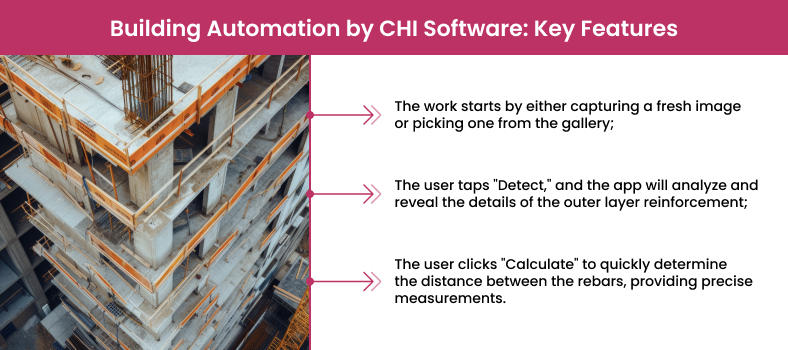
This software automates the control over reinforcing rod placement on construction sites.
The solution we made for our client was pretty simple to work with:
- First, users select/take a photo;
- Then, they press the “Detect” button and get the result of the outer layer reinforcement detection;
- Users can also click “Calculate” to measure the distance between rebars.
Even though operations are simple on the user side, the inner workings took quite a lot of time:
- CHI engineers used image preprocessing techniques based on computer vision to reduce noise, remove unnecessary objects from the image, and highlight the main rebars, separating them from inappropriate ones;
- We applied line detection with hough transform on images with high quality and fast inference;
- We used different color spaces and morphological image processing to detect tape;
- And finally, we added a lot of logic for post-processing to filter and select only appropriate rebars.
With the required deadline met and our client satisfied with the solution provided, we are proud to call this a job well done.
AI in Compliance Automation: Solution for Grant Seekers
Many organizations rely on grant support to finance their operations. Applying for grants involves developing and submitting a large pile of documents requiring much knowledge and focus. Procedures can be so complex that many organizations hire a dedicated employee to handle these tasks.
Learn how you can build an AI application from scratch
Click here
Our AI-powered solution aims to simplify and streamline all grant compliance procedures, ensuring that all necessary documentation and requirements are met in one location.

Such a solution can streamline all grant compliance procedures.
The AI-powered personal agent assists grant seekers in several ways:
- guides users through compliance procedures,
- provides real-time updates and notifications about deadlines and changes in regulation,
- reviews the documents provided by users, identifies errors and typos, and provides feedback and suggestions for improvements,
- smoothes out communication between grant seekers and compliance authorities and ensures transparency in compliance-related disputes.
As a result, organizations can successfully process grant documentation, simultaneously optimize their time and employee resources, and focus more on their core activities.
AI in Social Media: Intelligent Virtual Companion
During COVID-19 lockdowns, our client, a USA-based media startup, launched a social media networking platform styled as an online nightclub with opportunities for social interaction, like hosting parties, enjoying music and videos, and chatting.
As the new possibilities with ChatGPT emerged, we incorporated a Virtual Companion, an AI-powered conversational agent that can hold a natural and engaging conversation.
Describe your problem and get a ready-made solution based on best practices for AI implementation
Contact us
Our team has been training the Virtual Companion on the vast amounts of conversational data to enable it to perform several roles depending on user needs and expectations.
The Virtual Companion is trained to follow four different conversational patterns:
- emotional support with active listening and an empathetic approach;
- personal assistance which helps a person with to-do-lists, reminders, appointments, and informational support;
- language practice which helps master new languages and train in grammar, vocabulary, and pronunciation.
- entertainment by engaging in social interactions like trivia, online board games, storytelling, and jokes.
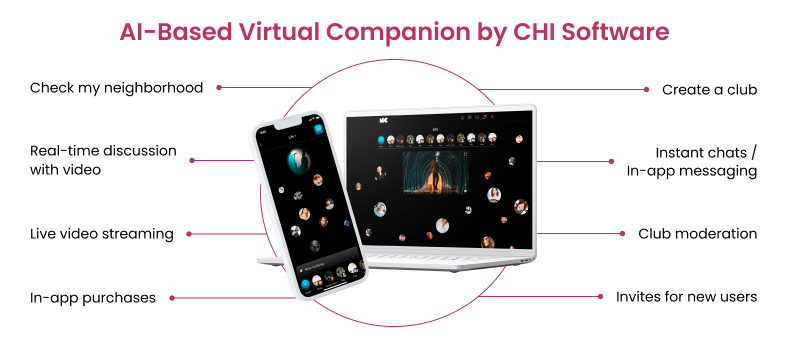
This is a social media networking platform styled as an online nightclub with opportunities for social interaction.
Users warmly met the Virtual Companion. The client reported several positive outcomes, such as customer retention growth, boosted engagement, improved brand differentiation on the market, and increased cross-sales due to personalized suggestions made by the Virtual Companion. Click here to learn more about this case study on our website.
Now, let’s talk about how to make your own AI.
How to Build AI Software? The 4 Key Steps to Consider
What does it take to create an AI software solution? What resources, people, and stages do you need? Let us look under the hood.
First, you should know that building AI solutions is an iterative process. The development pipeline in its basic form can be represented as:
- Research, discovery, and team planning,
- Model learning,
- Minimum viable product (MVP) development and further product improvements,
- Launching and support.
Now let us look closely at the first two (and the most important) stages of how to build an AI tool.

Research & Discovery
The first step is to clarify why we are going to create AI software and what we need to get started. Therefore, we identify:
- a problem-solving idea,
- pain points of the intended product users,
- value proposition,
- technologies to use,
- development milestones,
- AI metrics tied with business metrics.
Do you need deep data analysis to create an AI solution? We’ll take on the whole stage of the research
Contact us
Team Planning
To get a competitive product, we gather an experienced team for:
- Management and research: a project manager and a business analyst;
- Data analysis: data scientists, a dataset markup team, and ML engineers;
- Development: a solution architect, frontend and backend developers, AI specialists, and DevOps engineers;
- Testing: quality assurance (QA) engineers.
Platforms
AI platforms provide developers with ready-made tools for product building. They combine intelligent decision-making algorithms and data. Some platforms are easy to use, while others require deep coding expertise. Here are the most popular ones:
- Google platform. It consists of AI Hub (resources for developing artificial intelligence systems), AI Building Blocks, and AI Platform, a code-based data science environment for creating projects from idea to launch.
- Microsoft Azure. The platform helps create, train, and deploy models. You can also use cloud search with built-in AI capabilities of pattern identification in content, sentiment analysis, or key phrases extraction.
- AWS Machine Learning. Its services help build, train, and deploy ML models of any complexity. Amazon’s AWS delivers out-of-the-box analytics for companies and enterprises and simplifies software development.
- IBM Watson provides various tools to build, train, and deploy ML models. Additionally, the platform offers pre-trained models tailored for natural language processing, image recognition, and predictive analytics.
Oracle AI cloud services and the H2O ML platform with linear scalability are other options for engaging AI.
Programming Languages, Libraries, and Frameworks
The programming languages we commonly use for AI development are:
- Python. This language easily integrates with data structures, offers unique algorithms beyond standard programming, and allows developers to expand knowledge with libraries and tools such as NumPy, Pandas, Scikit, AIMA, etc.
- Java. An object-oriented language that differs in a thoughtful approach to exception handling, the availability of tools for developing multi-threaded software, and support for arrays, lists, and structures.
- C++. One of the fastest compilation languages globally allows you to implement highly complex logic without loss of performance. C++ suites are for software with high-speed animation and immediate user interaction with the rendering engine.
There is no universal recipe. To make AI software, developers select an optimal set of technologies for each particular case.
A detailed explanation on how to set up a recommendation engine with AI capabilities
Read more
Here are more examples of helpful tools our developers recommend for creating AI solutions:
- Frameworks: Caffe, Keras, PyTorch, Accord.NET, scikit-learn, and Spark MLlib;
- ML-as-a-Service platforms that allow developers to use graphical user interfaces such as IDEs and Jupyter Notebooks;
- APIs that get exposed as REST endpoints and return JSON with results (e.g., Azure Topic Detection API).
Model Learning
Every AI algorithm, even the most advanced one, needs appropriately collected and prepared data. Most often, our engineers use the Cross-Industry Standard Process for Data Mining (CRISP-DM) consisting of the following steps:
- Business understanding,
- Data understanding,
- Data preparation,
- Modeling,
- Evaluation,
- Deployment.

CHI Software stays up to date with the best engineering practices, including data mining standards.
In most cases, engineers apply steps cyclically and repeat them several times (besides deployment).
We usually have nothing except a project description at the discovery phase, but business and data understanding help us carefully learn an issue and find a solution.
Then we proceed to the data preparation stage. It involves selecting and uploading raw data, picking annotation tools, highlighting and labeling data blocks, and selecting and saving file formats.
Need advice on how to create artificial intelligence software? We will tell you where to start and how to run your project!
Contact us
The collected dataset allows us to compare solution options selected by the client. For this type of problem, choosing a metric for model comparison is crucial. So, it is necessary to establish success criteria and pick an option that best suits the client’s business goals.
After preparing the data, we determine the platform and programming languages to create AI software.
Modeling
At this point, engineers use previously collected data to train ML models via various methods. For instance, we at CHI Software apply deep learning or reinforcement learning techniques.
Evaluation & Deployment
When the model is trained, we have to evaluate it and make a decision to deploy it or go for another cycle of model learning. We can also deploy the current state of the model and continue to improve it.
Read more on successful ChatGPT use cases in our article
Click here
At the development and support stages, you can also optimize performance, improve and expand functionality, and adapt the product to updates of various operating systems.
What’s the Cost of AI? A Breakdown of Software Development Expenses
In this chapter, we’ll explore the various factors that contribute to AI software development costs. As you dive in, keep in mind that while the initial investment can be substantial, the long-term benefits of a well-executed AI solution often far outweigh the expenses.
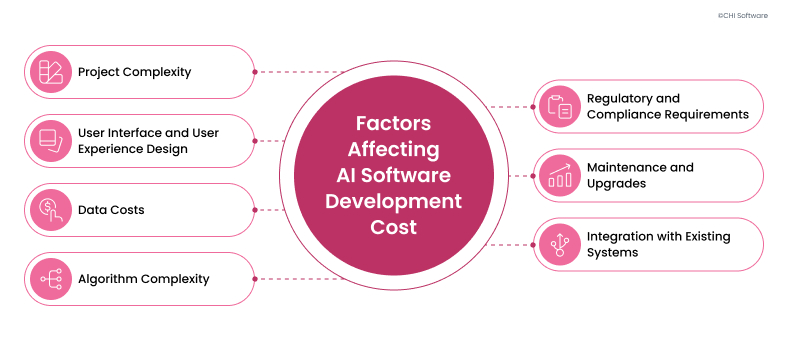
Consider these factors when planning your own AI solution and discuss them with an AI software development vendor.
Project Complexity
How to create your own AI software without sufficient data? The more complex your AI solution is, the higher the cost. A simple system can cost anywhere from USD 30,000. In contrast, more complicated systems, such as personalized recommendation systems, can cost up to USD 300,000.
User Interface and User Experience (UI/UX) Design
Investing in good UX/UI design can increase user engagement and satisfaction. However, high-quality design services can add 20%-30% to your costs.
Data Costs
Data is the lifeblood of AI systems and can be expensive to acquire. If you build a model that requires large datasets for training, you may need to purchase data or invest in data collection and cleaning processes.
Complexity of Algorithms
More complex algorithms, such as deep learning models, often require more computing power and longer training times. Depending on how complex the development will be, the price varies from USD 10 000 to 200 000.
Regulatory and Compliance Requirements
Depending on your industry, you may need to comply with regulations such as GDPR or HIPAA. Ensuring your AI solution complies with these requirements may require legal advice or additional security measures.
Maintenance and Upgrades
Once your AI software is up and running, you can’t just install it and forget about it. Maintenance, updates, and monitoring are necessary to ensure your solution functions properly and securely. Updates and testing of the model usually cost USD 10 000 – 30 000.
Integration with Existing Systems
The integration process requires a deep understanding of your current infrastructure, including any databases, software platforms, and APIs that need to interact with the AI system.
It is also essential to understand that integration is not a one-time setup. For an AI system to be effective, data pipelines are individually configured to ensure a smooth flow of data.
In short, developing an AI solution involves various costs that depend on its complexity. A basic AI setup is less costly, but expenses rise as you add features like advanced algorithms, quality UI/UX design, and regulatory compliance. Therefore, developing an AI solution can cost anywhere from USD 33,000 to USD 300,000. If you’re looking for more information, check out our article about AI development cost.
The Roadblocks to AI: Understanding Development Challenges
Learning how to create AI software is not enough. There are often obstacles on the way that can impede progress. Let us consider some of them.
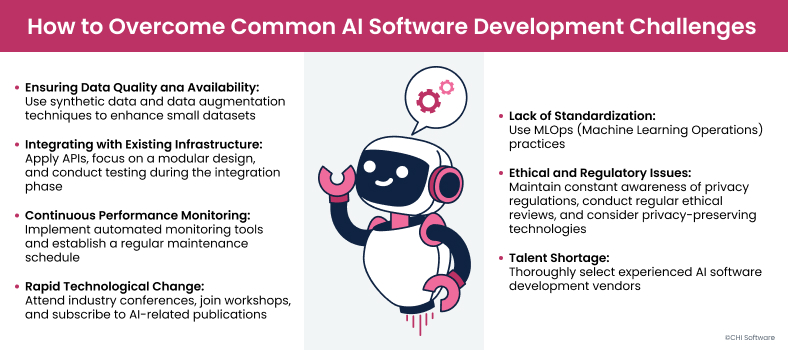
Stay informed about these challenges and ask your potential development partner how they usually overcome these issues.
Ensuring Data Quality and Availability
Poor quality or incomplete data can lead to inaccurate predictions and unreliable models. That’s why companies struggle to collect enough relevant data or clean up existing data, which is time-consuming. You can use data augmentation to enhance small datasets and add synthetic data to boost your training data.
Integrating with Existing Infrastructure
Integrating new AI solutions with your existing systems can be challenging because it often requires aligning different systems, data formats, and software that weren’t initially designed to work together.
Consider using APIs that allow your AI solution to seamlessly interact with your existing infrastructure and focus on a modular design to update components independently. We also recommend conducting testing during the integration phase to address any compatibility issues in advance.
Continuous Performance Monitoring
AI systems need constant monitoring to ensure that they perform correctly. You can implement automated monitoring tools to track performance metrics in real-time. Another option is establishing a regular maintenance schedule to update and retrain models as needed.
Rapid Technological Change
Companies must keep up with new technologies and methodologies to remain competitive and teams should focus on continuous learning as a priority. There are a lot of ways to stay up to date: attend industry conferences, join workshops, and subscribe to AI-related publications, which offer insights into the latest trends and advancements.
Lack of Standardization
Artificial intelligence is still relatively young, so best practices and standards constantly evolve, leaving organizations without clear guidelines for responsible AI implementation.
Using MLOps (Machine Learning Operations) is a good solution, as they provide necessary guidelines for creating reliable and secure AI solutions.
Ethical and Regulatory Issues
As the capabilities of artificial intelligence continue to grow, so does the attention to its ethical use. Companies are under pressure to guarantee that decisions made with AI are fair and transparent.
First and foremost, we advise maintaining constant awareness of privacy regulations and conducting regular ethical reviews to ensure your AI solution use remains compliant and responsible.
You can also consider privacy-preserving technologies like federated learning. This approach allows your organization to train models on sensitive data without transferring it to a central server, helping you safeguard privacy while leveraging AI’s benefits.
Talent Shortage
As AI is a relatively new and rapidly developing field, the lack of qualified professionals is another obstacle. This problem can be solved by turning to an experienced partner who knows exactly how to make artificial intelligence software. Here are some tips for choosing the right vendor:
- Experience: Look for a vendor with a solid experience in AI development to ensure they have the skills you need.
- Customized solutions: Choose a partner that can tailor their services to your specific needs.
- Support: Make sure they provide ongoing support and service. This way, you can ask for help if you have any issues.
- Stay current: Vendors must be up-to-date with the latest AI trends to keep your project competitive.
- Check references: Check their portfolio and find out what previous clients think of their work.
Whether you’re just starting with AI or looking to expand an existing project, CHI Software is here to help. Check out our portfolio to see how we’ve brought AI ideas to life for our clients. Contact us to find out how we can bring your AI vision to life quickly and efficiently.
Conclusion
We briefly touched on the points to understand how to make AI software. But this field is incredibly wide, and it is simply impossible to cover all the details in one guide.
Therefore, if you want to let artificial intelligence into your business, it is best and most appropriate to turn to professionals. A company focused on AI-based software development can help you build the most efficient, resource-saving, and customer-centric solution. So make the first step to the AI-driven success of your business and contact our highly competent experts today for Generative AI Development services and more.
FAQs
Here is what you need to know about IT consulting in a nutshell.
-
How do IT consulting services help my business?

Information technology consulting helps you find room for business improvement using IT solutions and oversee possible threats and unwanted activities. It significantly decreases potential risks and costs related to the technology sector, whether you build a new solution from scratch or upgrade an existing system.
-
Who are IT consultants, and what do they do?

An IT consultant is a specialist providing consultations about technology use based on unique business goals, product characteristics, and market conditions. Such experts learn vast data sets to offer the best possible solution to a specific company considering current business pain points and customer expectations.
-
What software consulting services does CHI Software offer?

As an information technology consulting company, we offer a complete spectrum of consulting services, including: • Detailed market analysis with possible risks overviewed, • Expert reviews provided by UI/UX designers, developers, solution architects, etc., • Tech stack suggestions, • IT implementation plan, • Time and cost estimation of the IT project, • Well-defined project requirements.
About the author
Alex is a Data Scientist & ML Engineer with an NLP specialization. He is passionate about AI-related technologies, fond of science, and participated in many international scientific conferences.
Rate this article
24 ratings, average: 4.5 out of 5













